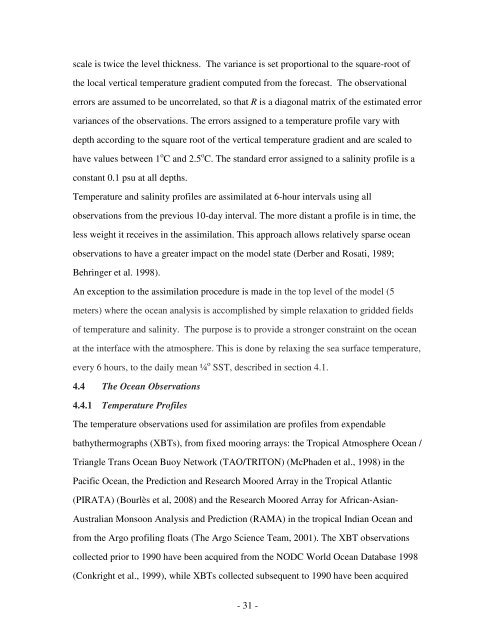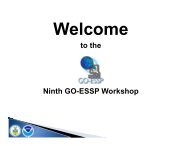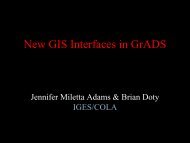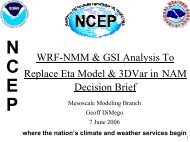y Gent and McWilliams (1990; see also Griffies et al. 1998). <strong>The</strong> horizontal mixing ofmomentum uses the nonlinear scheme of Smagorinsky (see Griffies and Halberg, 2000).We have used a configuration for the MOM4p0d similar to the one we used for the MOM3in the current operational CFS (Saha et al., 2006), but we have approximately doubled theresolution and the MOM4p0d is fully global with an Arctic Ocean and interactive ice model,where the operational MOM3 is truncated at 64 o N and 74 o S.4.3 <strong>The</strong> Ocean Analysis: GODAS<strong>The</strong> Global Ocean Data Assimilation <strong>System</strong> (GODAS) at <strong>NCEP</strong> uses a 3DVARassimilation scheme that has evolved from a version originally developed by Derber andRosati (1989). It was first adopted to assimilate temperature data into a Pacific Oceanmodel and subsequently modified to assimilate other data sets (Behringer et al., 1998; Jiet al., 2000; Behringer and Xue, 2004; Behringer, 2007). In the context of the CFSR theGODAS assimilates temperature and salinity observations by minimizing the costfunction:J = ½ (x-x b ) T B -1 (x-x b ) + ½ (y-H(x)) T R -1 (y-H(x)),where the first term is the sum of the squared differences between the forecast, x b , and theanalysis, x, weighted by the uncertainty of the forecast and the second term is the sum ofthe squared differences between the observations, y, and the analysis, H(x), weighted bythe uncertainty of the observations. <strong>The</strong> operator, H, is a linear interpolator between themodel grid and the location of the observation. <strong>The</strong> matrix B is the background errorcovariance and the matrix R is the observational error covariance that includes therepresentation error, due to the part of the observed field that the model is unable toresolve. <strong>The</strong> background error covariance matrix, B, is univariate and thus block diagonalwith respect to temperature and salinity. <strong>The</strong> horizontal covariance is modeled using adiffusion equation approximating a Gaussian function that is stretched in the zonaldirection with the stretching being greatest near the equator (Derber and Rosati, 1989;Weaver and Courtier, 2001). <strong>The</strong> vertical covariance is likewise modeled with a diffusionequation with length scales specified as a function of depth such that at any level the- 30 -
scale is twice the level thickness. <strong>The</strong> variance is set proportional to the square-root ofthe local vertical temperature gradient computed from the forecast. <strong>The</strong> observationalerrors are assumed to be uncorrelated, so that R is a diagonal matrix of the estimated errorvariances of the observations. <strong>The</strong> errors assigned to a temperature profile vary withdepth according to the square root of the vertical temperature gradient and are scaled tohave values between 1 o C and 2.5 o C. <strong>The</strong> standard error assigned to a salinity profile is aconstant 0.1 psu at all depths.Temperature and salinity profiles are assimilated at 6-hour intervals using allobservations from the previous 10-day interval. <strong>The</strong> more distant a profile is in time, theless weight it receives in the assimilation. This approach allows relatively sparse oceanobservations to have a greater impact on the model state (Derber and Rosati, 1989;Behringer et al. 1998).An exception to the assimilation procedure is made in the top level of the model (5meters) where the ocean analysis is accomplished by simple relaxation to gridded fieldsof temperature and salinity. <strong>The</strong> purpose is to provide a stronger constraint on the oceanat the interface with the atmosphere. This is done by relaxing the sea surface temperature,every 6 hours, to the daily mean ¼ o SST, described in section 4.1.4.4 <strong>The</strong> Ocean Observations4.4.1 Temperature Profiles<strong>The</strong> temperature observations used for assimilation are profiles from expendablebathythermographs (XBTs), from fixed mooring arrays: the Tropical Atmosphere Ocean /Triangle Trans Ocean Buoy Network (TAO/TRITON) (McPhaden et al., 1998) in thePacific Ocean, the Prediction and Research Moored Array in the Tropical Atlantic(PIRATA) (Bourlès et al, 2008) and the Research Moored Array for African-Asian-Australian Monsoon Analysis and Prediction (RAMA) in the tropical Indian Ocean andfrom the Argo profiling floats (<strong>The</strong> Argo Science Team, 2001). <strong>The</strong> XBT observationscollected prior to 1990 have been acquired from the NODC World Ocean Database 1998(Conkright et al., 1999), while XBTs collected subsequent to 1990 have been acquired- 31 -
- Page 2 and 3: ABSTRACTThe NCEP Climate Forecast S
- Page 4 and 5: 1. IntroductionThe first reanalysis
- Page 6 and 7: In this paper we only discuss globa
- Page 8 and 9: the reanalysis was halted to addres
- Page 10 and 11: online archive of data for reanalys
- Page 12 and 13: density MESONET data is included in
- Page 14 and 15: The 1B datasets were calibrated usi
- Page 16 and 17: MetOp is Europe's first polar-orbit
- Page 20 and 21: The third GSI feature enabled in th
- Page 22 and 23: the hydrostatic assumption. Soon af
- Page 24 and 25: esolution with 28 sigma layers in t
- Page 26 and 27: SW and LW radiations at one-hour in
- Page 28 and 29: SST data. The other uses AVHRR and
- Page 32 and 33: from the Global Temperature-Salinit
- Page 34 and 35: through the end of the data set in
- Page 36 and 37: The passive microwave weather filte
- Page 39 and 40: from the sea ice/ocean back to the
- Page 41 and 42: weight is assigned to the gauge ana
- Page 43 and 44: Stream 6: 1 Jan 1994 to 31 Mar 1999
- Page 45 and 46: in the mid 1990’s, the period whe
- Page 47: e due to a change over the oceans (
- Page 52 and 53: In Figure 49, we show the temporal
- Page 54 and 55: distributed in time and space. Desp
- Page 56 and 57: forecast model at a lower resolutio
- Page 58 and 59: Appendix A: AcronymsAER Atmospheric
- Page 60 and 61: ONPCMDIPIRATAPROFLRQBOQuikSCATR1R2R
- Page 62 and 63: TMP2M 2m air temperature 24 / 473TM
- Page 64 and 65: Appendix C: The Data AccessTo addre
- Page 66 and 67: Figure 26 shows the global total bi
- Page 68 and 69: Argo Science Team, 2001: The global
- Page 70 and 71: Compo, G.P., J.S. Whitaker, and P.D
- Page 72 and 73: ozone Mapping and Profiler Suite (O
- Page 75 and 76: Global Forecast System. Manuscript
- Page 77 and 78: and climate models. Atmos. Chem. Ph
- Page 79 and 80: performance Earth system modeling w
- Page 81 and 82:
with mesoscale numerical weather pr
- Page 83 and 84:
experiments using SSM/I wind speed
- Page 85 and 86:
Figure 21: Same as Figure 2, but fo
- Page 87 and 88:
Figure 45: The fit of 6-hour foreca
- Page 89 and 90:
Figure 1: Diagram illustrating CFSR
- Page 91 and 92:
Figure 3: Same as in Figure 2, but
- Page 93 and 94:
Figure 5: Same as in Figure 2, but
- Page 95 and 96:
Figure 7: Same as in Figure 2, but
- Page 97 and 98:
Figure 9: Same as in Figure 2, but
- Page 99 and 100:
Figure 11: Same as in Figure 2, but
- Page 101 and 102:
Figure 13: Same as in Figure 2, but
- Page 103 and 104:
Figure 15: Radiance instruments on
- Page 105 and 106:
Figure 17: Same as in Figure 16, bu
- Page 107 and 108:
Figure 19: Global average Tb first
- Page 109 and 110:
Figure 21: Same as in Figure 16, bu
- Page 111:
Figure 23: Comparisons of the SSU b
- Page 114 and 115:
Figure 26: The global total bias fo
- Page 116 and 117:
Figure 28: The yearly total of trop
- Page 118 and 119:
Figure 30: The vertical structure o
- Page 120 and 121:
Figure 32: The global number of tem
- Page 122 and 123:
Figure 34: The same as Figure 33, b
- Page 124 and 125:
Figure 36: Monthly mean Sea ice ext
- Page 126 and 127:
Figure 38: 2-meter volumetric soil
- Page 128 and 129:
Figure 40: Schematic of the executi
- Page 130 and 131:
Figure 42: Yearly averaged Southern
- Page 132 and 133:
Figure 44: Monthly mean hourly surf
- Page 134 and 135:
Figure 46: Global mean temperature
- Page 136 and 137:
Figure 48: Zonal mean total ozone d
- Page 138 and 139:
Figure 50: The subsurface temperatu
- Page 140 and 141:
Figure 52: Vertical profiles of the
- Page 142 and 143:
Figure 54: Zonal surface velocities
- Page 144 and 145:
ProgramPREVENTSACQCACAR_CQCCQCCQCVA
- Page 146:
Satellite Starting date Ending Date





